Heat Transfer Analysis: Chemical Engineering Assignment
VerifiedAdded on 2022/10/06
|7
|957
|15
Homework Assignment
AI Summary
This chemical engineering assignment addresses heat transfer principles through several questions. The solution begins by exploring methods to enhance heat transfer from a body, focusing on the driving forces behind cooling processes and the impact of temperature changes. It includes experimental data analysis, calculating heat loss and the empirical relationships between heat loss and temperature differences. The assignment further delves into the calculation of heat transfer coefficients, volumetric flow rates, and surface areas, using provided data and formulas. The solution also discusses discrepancies between calculated and recorded values of the heat transfer coefficient, attributing them to experimental errors. Finally, the assignment concludes with a discussion on how to redesign TENCAS (assumed to be a type of clothing) to enhance heat transfer, suggesting design modifications that promote air circulation.
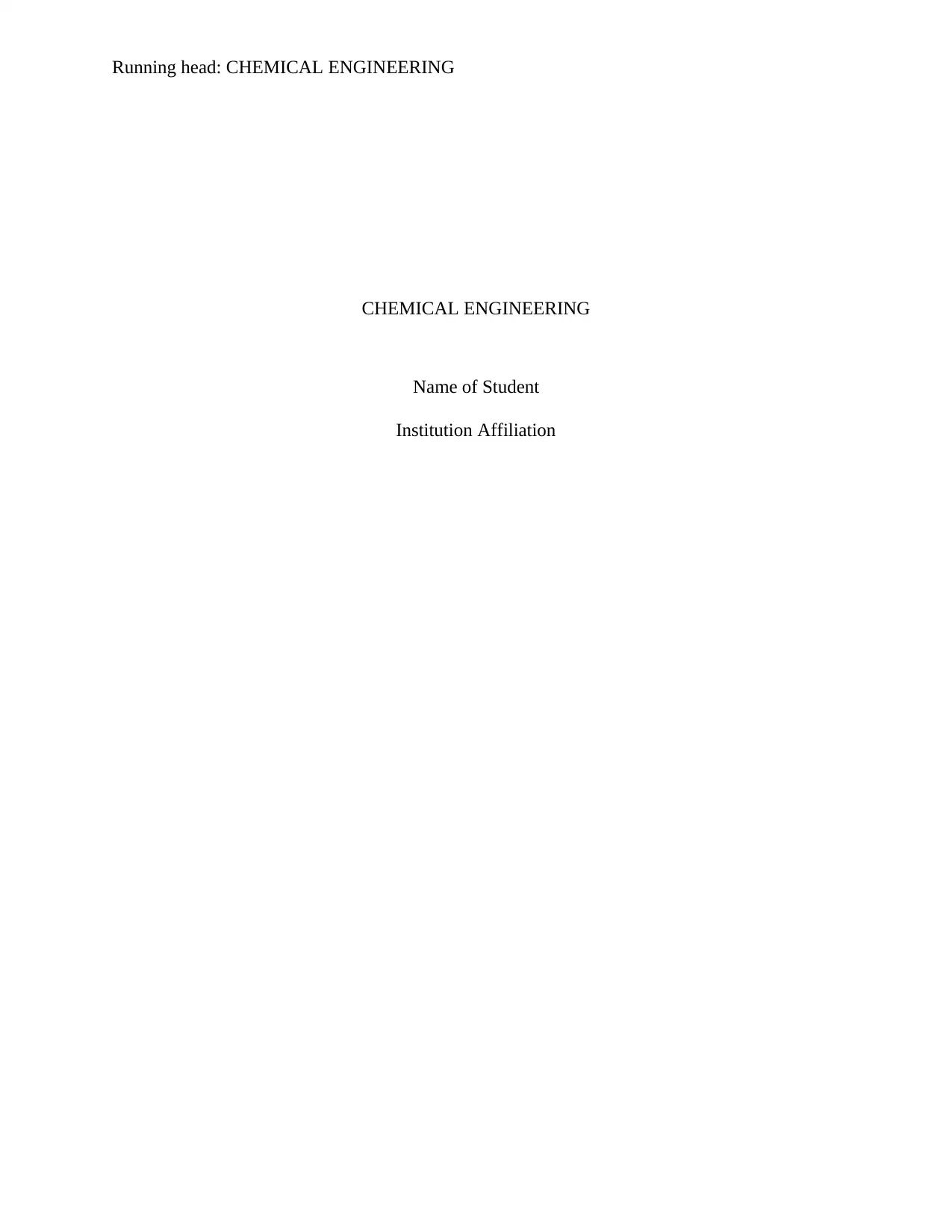
Running head: CHEMICAL ENGINEERING
CHEMICAL ENGINEERING
Name of Student
Institution Affiliation
CHEMICAL ENGINEERING
Name of Student
Institution Affiliation
Paraphrase This Document
Need a fresh take? Get an instant paraphrase of this document with our AI Paraphraser
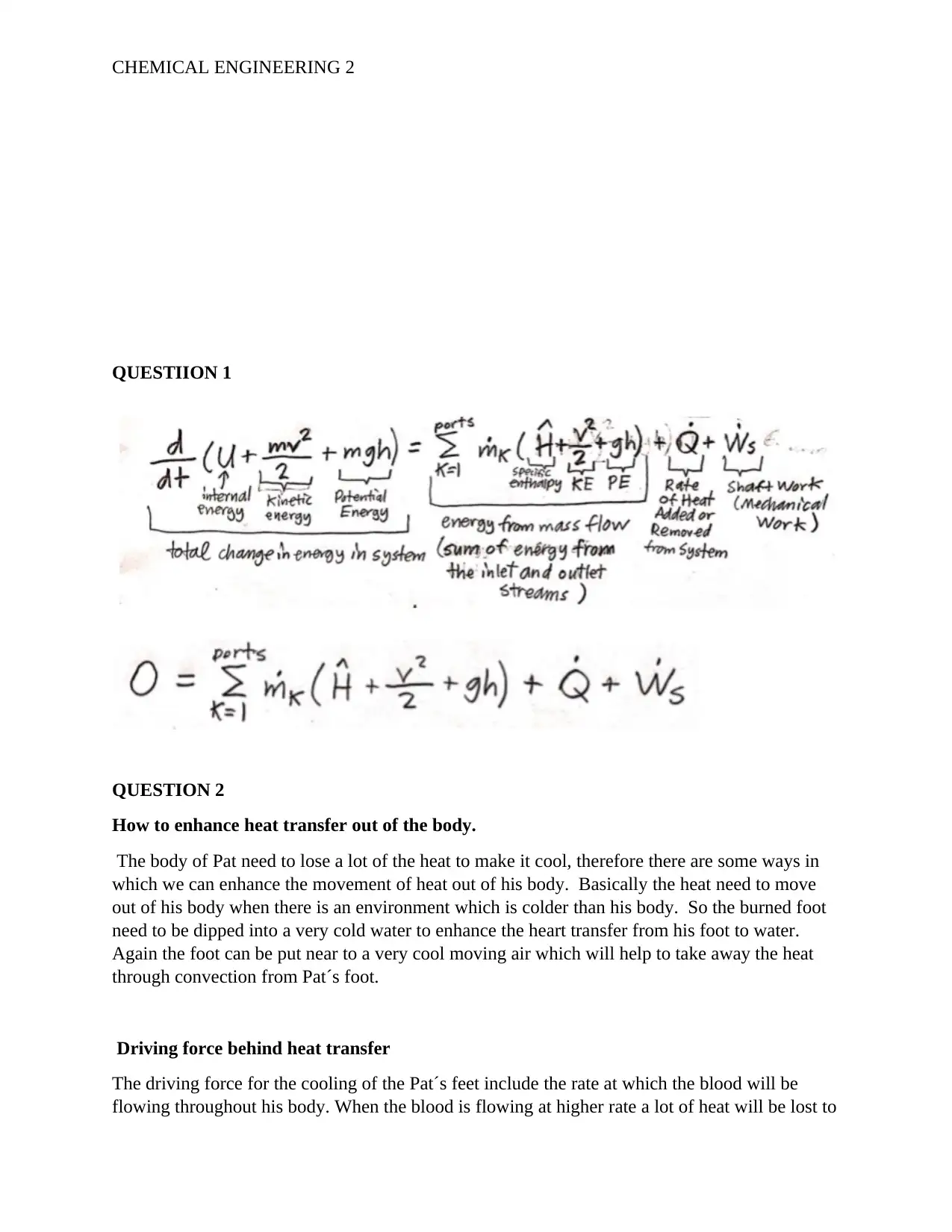
CHEMICAL ENGINEERING 2
QUESTIION 1
QUESTION 2
How to enhance heat transfer out of the body.
The body of Pat need to lose a lot of the heat to make it cool, therefore there are some ways in
which we can enhance the movement of heat out of his body. Basically the heat need to move
out of his body when there is an environment which is colder than his body. So the burned foot
need to be dipped into a very cold water to enhance the heart transfer from his foot to water.
Again the foot can be put near to a very cool moving air which will help to take away the heat
through convection from Pat´s foot.
Driving force behind heat transfer
The driving force for the cooling of the Pat´s feet include the rate at which the blood will be
flowing throughout his body. When the blood is flowing at higher rate a lot of heat will be lost to
QUESTIION 1
QUESTION 2
How to enhance heat transfer out of the body.
The body of Pat need to lose a lot of the heat to make it cool, therefore there are some ways in
which we can enhance the movement of heat out of his body. Basically the heat need to move
out of his body when there is an environment which is colder than his body. So the burned foot
need to be dipped into a very cold water to enhance the heart transfer from his foot to water.
Again the foot can be put near to a very cool moving air which will help to take away the heat
through convection from Pat´s foot.
Driving force behind heat transfer
The driving force for the cooling of the Pat´s feet include the rate at which the blood will be
flowing throughout his body. When the blood is flowing at higher rate a lot of heat will be lost to
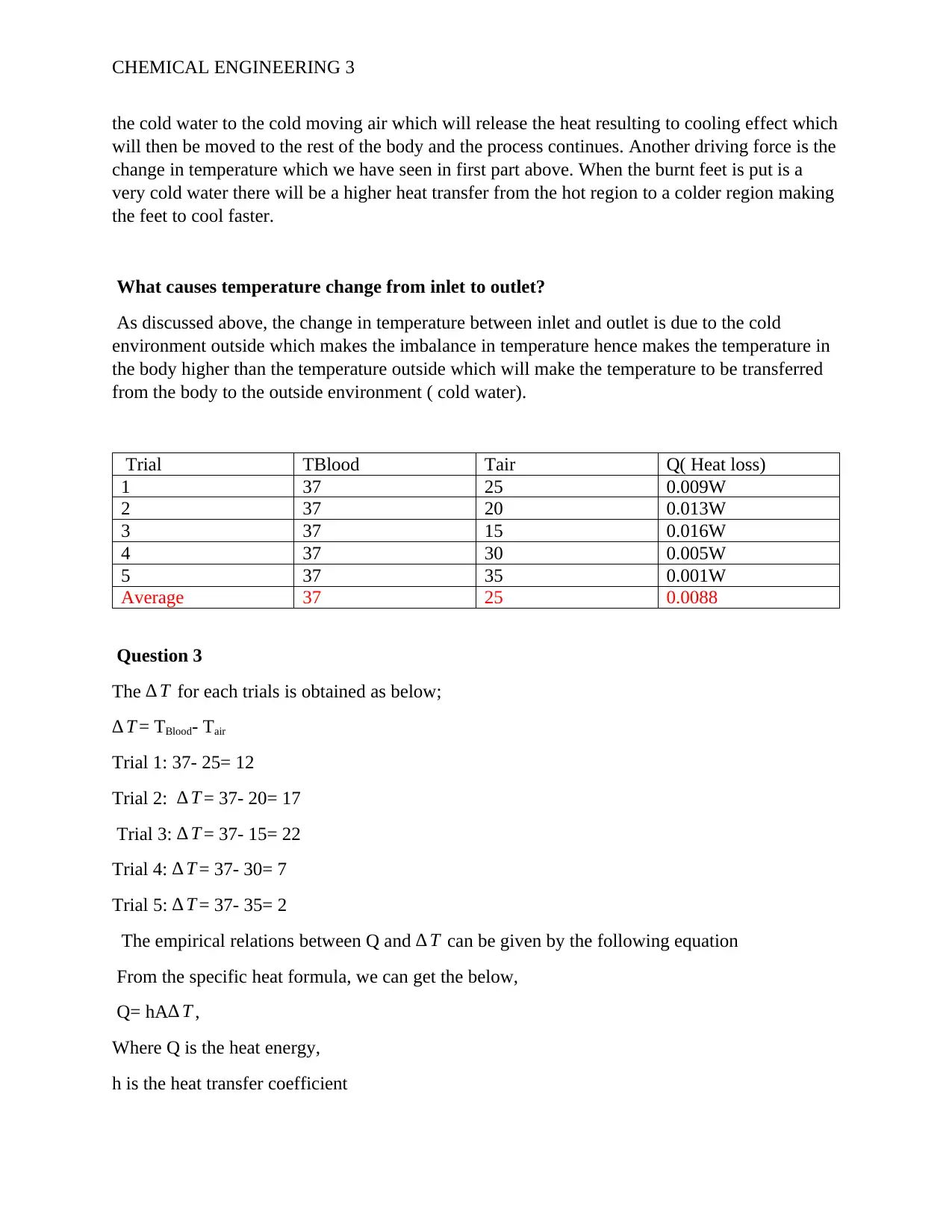
CHEMICAL ENGINEERING 3
the cold water to the cold moving air which will release the heat resulting to cooling effect which
will then be moved to the rest of the body and the process continues. Another driving force is the
change in temperature which we have seen in first part above. When the burnt feet is put is a
very cold water there will be a higher heat transfer from the hot region to a colder region making
the feet to cool faster.
What causes temperature change from inlet to outlet?
As discussed above, the change in temperature between inlet and outlet is due to the cold
environment outside which makes the imbalance in temperature hence makes the temperature in
the body higher than the temperature outside which will make the temperature to be transferred
from the body to the outside environment ( cold water).
Trial TBlood Tair Q( Heat loss)
1 37 25 0.009W
2 37 20 0.013W
3 37 15 0.016W
4 37 30 0.005W
5 37 35 0.001W
Average 37 25 0.0088
Question 3
The ∆ T for each trials is obtained as below;
∆ T = TBlood- Tair
Trial 1: 37- 25= 12
Trial 2: ∆ T = 37- 20= 17
Trial 3: ∆ T = 37- 15= 22
Trial 4: ∆ T = 37- 30= 7
Trial 5: ∆ T = 37- 35= 2
The empirical relations between Q and ∆ T can be given by the following equation
From the specific heat formula, we can get the below,
Q= hA∆ T ,
Where Q is the heat energy,
h is the heat transfer coefficient
the cold water to the cold moving air which will release the heat resulting to cooling effect which
will then be moved to the rest of the body and the process continues. Another driving force is the
change in temperature which we have seen in first part above. When the burnt feet is put is a
very cold water there will be a higher heat transfer from the hot region to a colder region making
the feet to cool faster.
What causes temperature change from inlet to outlet?
As discussed above, the change in temperature between inlet and outlet is due to the cold
environment outside which makes the imbalance in temperature hence makes the temperature in
the body higher than the temperature outside which will make the temperature to be transferred
from the body to the outside environment ( cold water).
Trial TBlood Tair Q( Heat loss)
1 37 25 0.009W
2 37 20 0.013W
3 37 15 0.016W
4 37 30 0.005W
5 37 35 0.001W
Average 37 25 0.0088
Question 3
The ∆ T for each trials is obtained as below;
∆ T = TBlood- Tair
Trial 1: 37- 25= 12
Trial 2: ∆ T = 37- 20= 17
Trial 3: ∆ T = 37- 15= 22
Trial 4: ∆ T = 37- 30= 7
Trial 5: ∆ T = 37- 35= 2
The empirical relations between Q and ∆ T can be given by the following equation
From the specific heat formula, we can get the below,
Q= hA∆ T ,
Where Q is the heat energy,
h is the heat transfer coefficient
⊘ This is a preview!⊘
Do you want full access?
Subscribe today to unlock all pages.

Trusted by 1+ million students worldwide
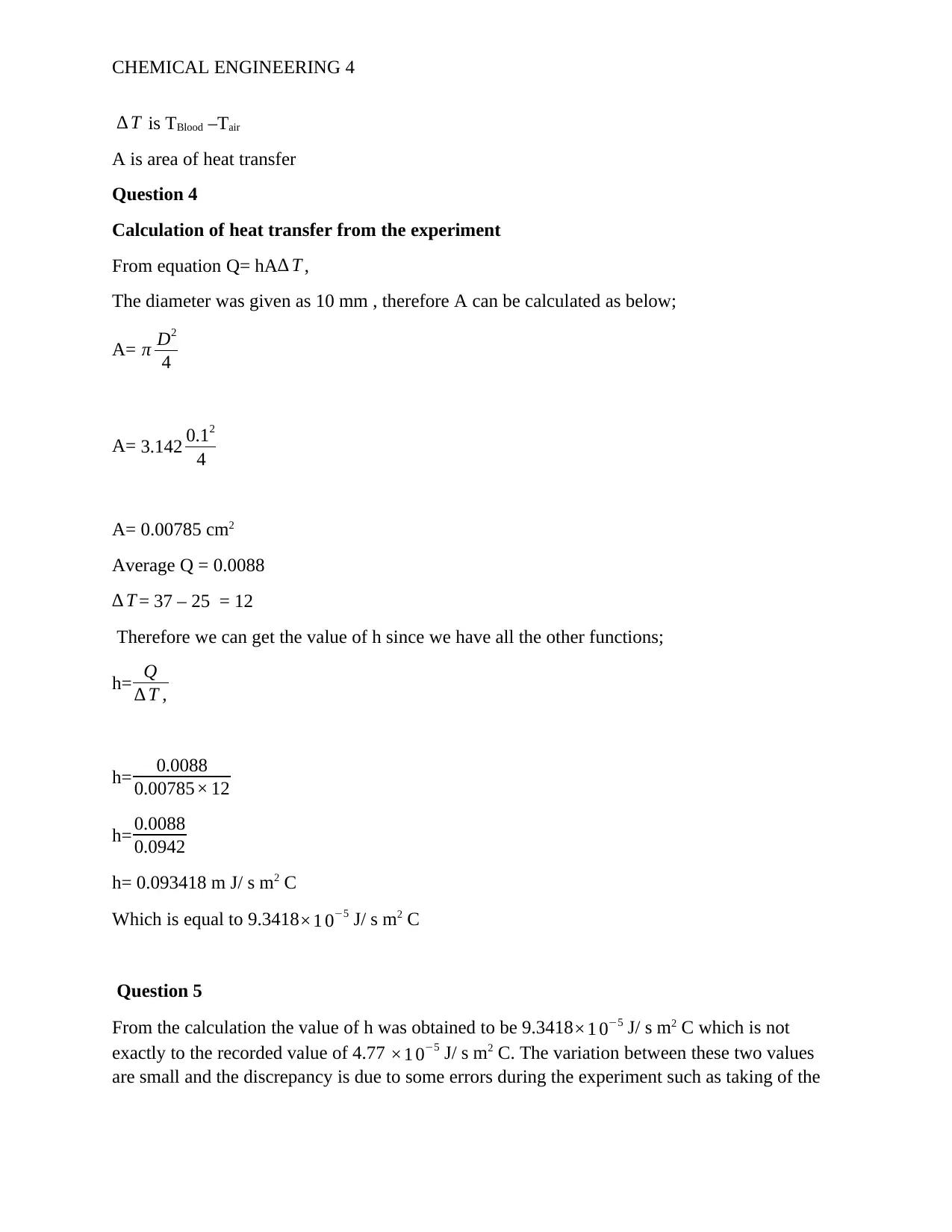
CHEMICAL ENGINEERING 4
∆ T is TBlood –Tair
A is area of heat transfer
Question 4
Calculation of heat transfer from the experiment
From equation Q= hA∆ T ,
The diameter was given as 10 mm , therefore A can be calculated as below;
A= π D2
4
A= 3.142 0.12
4
A= 0.00785 cm2
Average Q = 0.0088
∆ T = 37 – 25 = 12
Therefore we can get the value of h since we have all the other functions;
h= Q
∆ T ,
h= 0.0088
0.00785× 12
h= 0.0088
0.0942
h= 0.093418 m J/ s m2 C
Which is equal to 9.3418×1 0−5 J/ s m2 C
Question 5
From the calculation the value of h was obtained to be 9.3418×1 0−5 J/ s m2 C which is not
exactly to the recorded value of 4.77 ×1 0−5 J/ s m2 C. The variation between these two values
are small and the discrepancy is due to some errors during the experiment such as taking of the
∆ T is TBlood –Tair
A is area of heat transfer
Question 4
Calculation of heat transfer from the experiment
From equation Q= hA∆ T ,
The diameter was given as 10 mm , therefore A can be calculated as below;
A= π D2
4
A= 3.142 0.12
4
A= 0.00785 cm2
Average Q = 0.0088
∆ T = 37 – 25 = 12
Therefore we can get the value of h since we have all the other functions;
h= Q
∆ T ,
h= 0.0088
0.00785× 12
h= 0.0088
0.0942
h= 0.093418 m J/ s m2 C
Which is equal to 9.3418×1 0−5 J/ s m2 C
Question 5
From the calculation the value of h was obtained to be 9.3418×1 0−5 J/ s m2 C which is not
exactly to the recorded value of 4.77 ×1 0−5 J/ s m2 C. The variation between these two values
are small and the discrepancy is due to some errors during the experiment such as taking of the
Paraphrase This Document
Need a fresh take? Get an instant paraphrase of this document with our AI Paraphraser
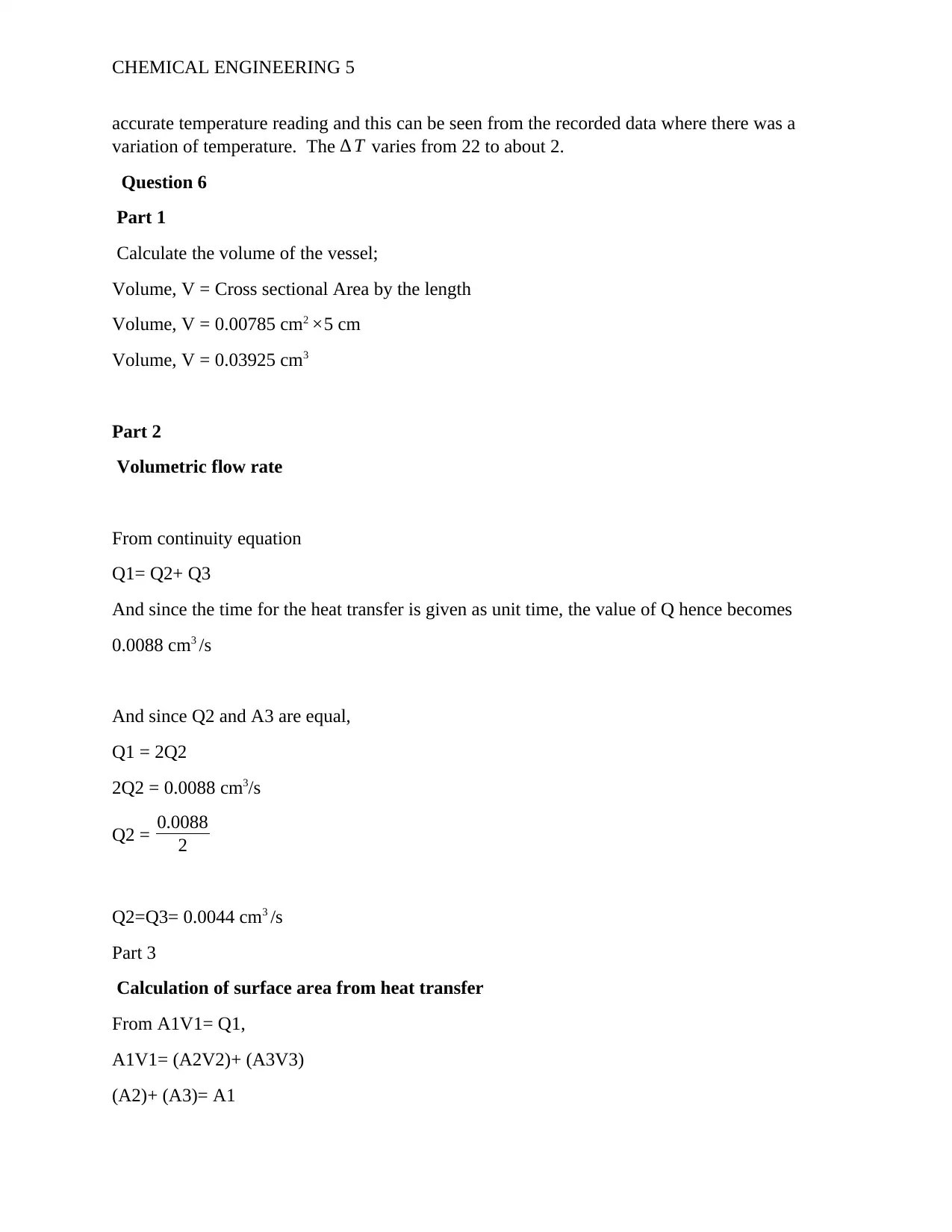
CHEMICAL ENGINEERING 5
accurate temperature reading and this can be seen from the recorded data where there was a
variation of temperature. The ∆ T varies from 22 to about 2.
Question 6
Part 1
Calculate the volume of the vessel;
Volume, V = Cross sectional Area by the length
Volume, V = 0.00785 cm2 ×5 cm
Volume, V = 0.03925 cm3
Part 2
Volumetric flow rate
From continuity equation
Q1= Q2+ Q3
And since the time for the heat transfer is given as unit time, the value of Q hence becomes
0.0088 cm3 /s
And since Q2 and A3 are equal,
Q1 = 2Q2
2Q2 = 0.0088 cm3/s
Q2 = 0.0088
2
Q2=Q3= 0.0044 cm3 /s
Part 3
Calculation of surface area from heat transfer
From A1V1= Q1,
A1V1= (A2V2)+ (A3V3)
(A2)+ (A3)= A1
accurate temperature reading and this can be seen from the recorded data where there was a
variation of temperature. The ∆ T varies from 22 to about 2.
Question 6
Part 1
Calculate the volume of the vessel;
Volume, V = Cross sectional Area by the length
Volume, V = 0.00785 cm2 ×5 cm
Volume, V = 0.03925 cm3
Part 2
Volumetric flow rate
From continuity equation
Q1= Q2+ Q3
And since the time for the heat transfer is given as unit time, the value of Q hence becomes
0.0088 cm3 /s
And since Q2 and A3 are equal,
Q1 = 2Q2
2Q2 = 0.0088 cm3/s
Q2 = 0.0088
2
Q2=Q3= 0.0044 cm3 /s
Part 3
Calculation of surface area from heat transfer
From A1V1= Q1,
A1V1= (A2V2)+ (A3V3)
(A2)+ (A3)= A1
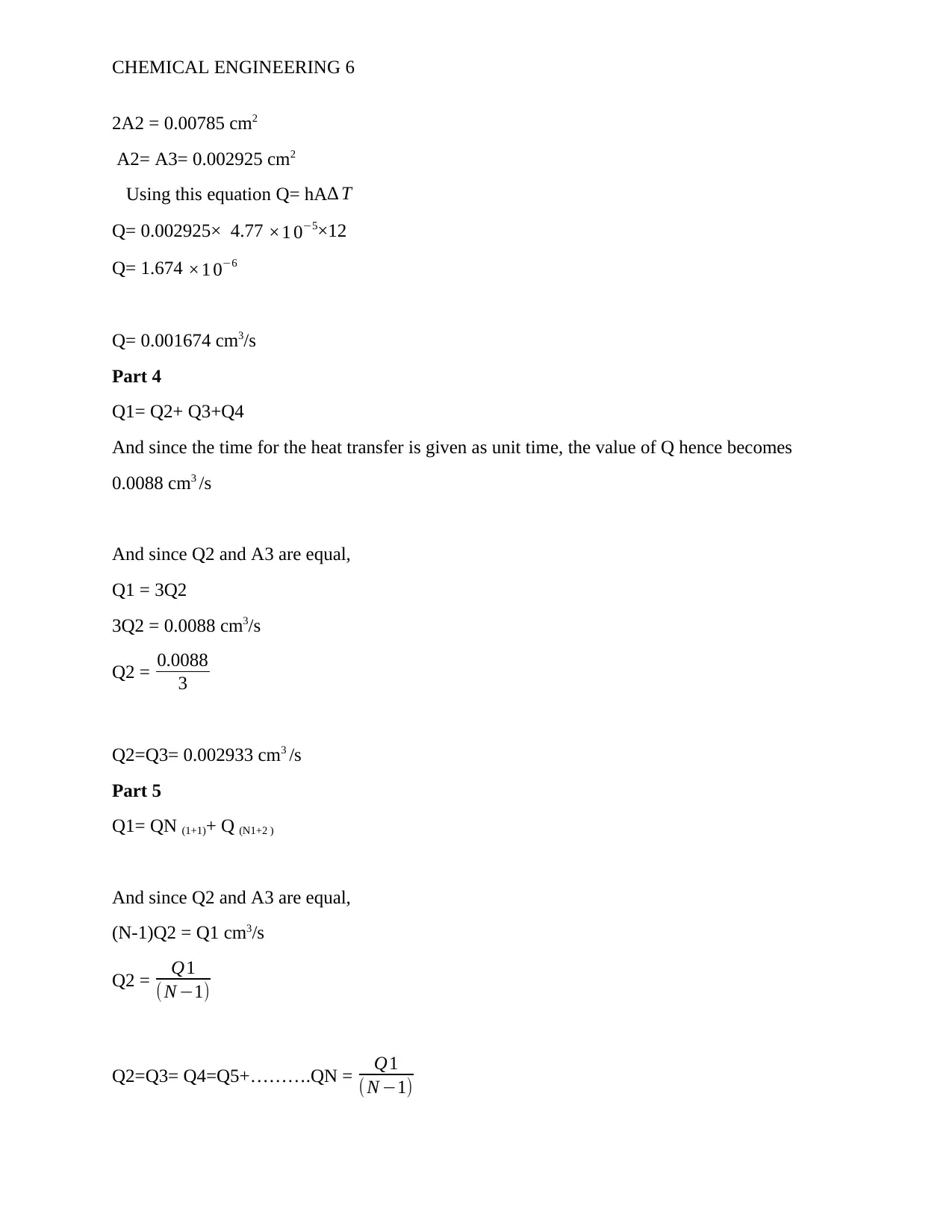
CHEMICAL ENGINEERING 6
2A2 = 0.00785 cm2
A2= A3= 0.002925 cm2
Using this equation Q= hA∆ T
Q= 0.002925× 4.77 ×1 0−5×12
Q= 1.674 ×1 0−6
Q= 0.001674 cm3/s
Part 4
Q1= Q2+ Q3+Q4
And since the time for the heat transfer is given as unit time, the value of Q hence becomes
0.0088 cm3 /s
And since Q2 and A3 are equal,
Q1 = 3Q2
3Q2 = 0.0088 cm3/s
Q2 = 0.0088
3
Q2=Q3= 0.002933 cm3 /s
Part 5
Q1= QN (1+1)+ Q (N1+2 )
And since Q2 and A3 are equal,
(N-1)Q2 = Q1 cm3/s
Q2 = Q1
( N −1)
Q2=Q3= Q4=Q5+……….QN = Q1
( N −1)
2A2 = 0.00785 cm2
A2= A3= 0.002925 cm2
Using this equation Q= hA∆ T
Q= 0.002925× 4.77 ×1 0−5×12
Q= 1.674 ×1 0−6
Q= 0.001674 cm3/s
Part 4
Q1= Q2+ Q3+Q4
And since the time for the heat transfer is given as unit time, the value of Q hence becomes
0.0088 cm3 /s
And since Q2 and A3 are equal,
Q1 = 3Q2
3Q2 = 0.0088 cm3/s
Q2 = 0.0088
3
Q2=Q3= 0.002933 cm3 /s
Part 5
Q1= QN (1+1)+ Q (N1+2 )
And since Q2 and A3 are equal,
(N-1)Q2 = Q1 cm3/s
Q2 = Q1
( N −1)
Q2=Q3= Q4=Q5+……….QN = Q1
( N −1)
⊘ This is a preview!⊘
Do you want full access?
Subscribe today to unlock all pages.

Trusted by 1+ million students worldwide
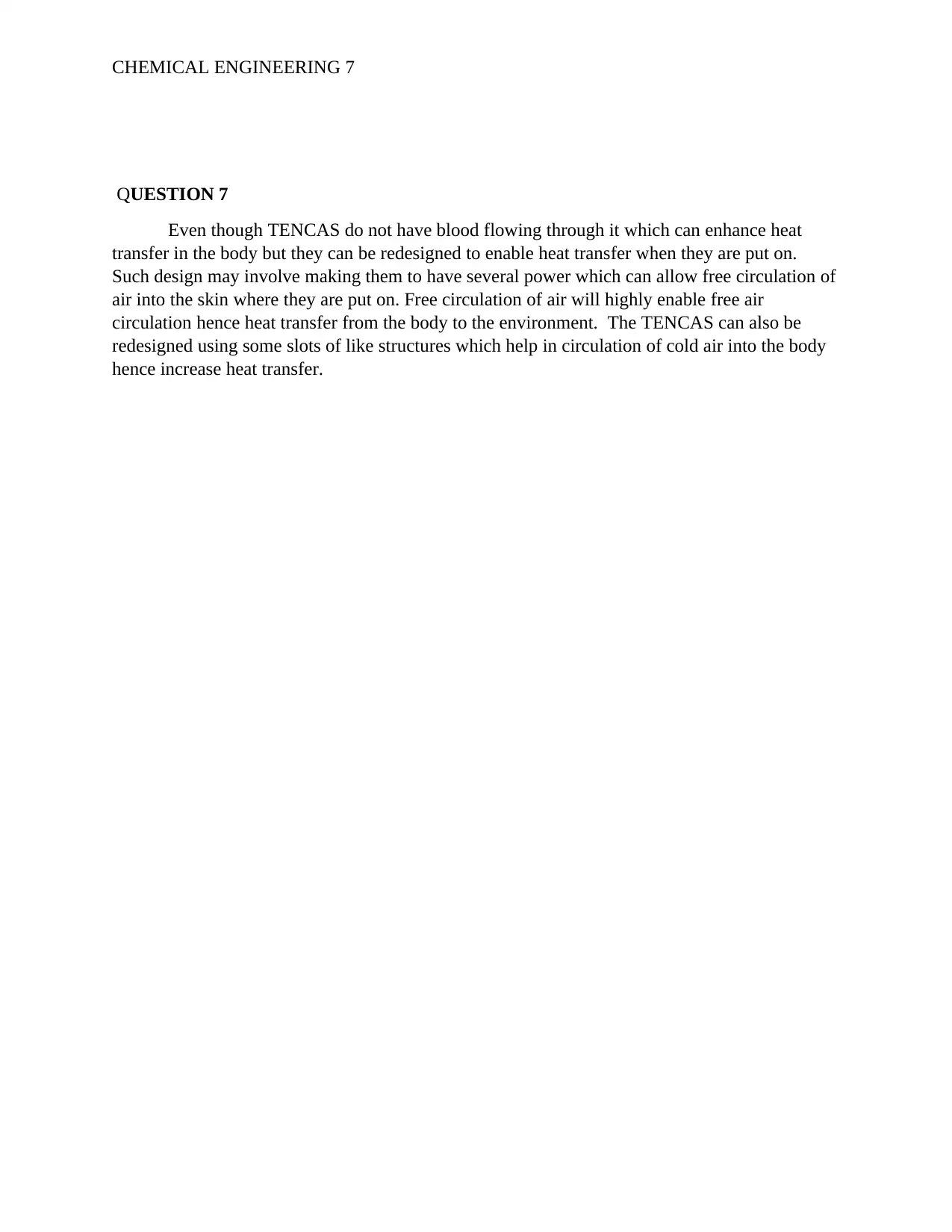
CHEMICAL ENGINEERING 7
QUESTION 7
Even though TENCAS do not have blood flowing through it which can enhance heat
transfer in the body but they can be redesigned to enable heat transfer when they are put on.
Such design may involve making them to have several power which can allow free circulation of
air into the skin where they are put on. Free circulation of air will highly enable free air
circulation hence heat transfer from the body to the environment. The TENCAS can also be
redesigned using some slots of like structures which help in circulation of cold air into the body
hence increase heat transfer.
QUESTION 7
Even though TENCAS do not have blood flowing through it which can enhance heat
transfer in the body but they can be redesigned to enable heat transfer when they are put on.
Such design may involve making them to have several power which can allow free circulation of
air into the skin where they are put on. Free circulation of air will highly enable free air
circulation hence heat transfer from the body to the environment. The TENCAS can also be
redesigned using some slots of like structures which help in circulation of cold air into the body
hence increase heat transfer.
1 out of 7
Related Documents
Your All-in-One AI-Powered Toolkit for Academic Success.
+13062052269
info@desklib.com
Available 24*7 on WhatsApp / Email
![[object Object]](/_next/static/media/star-bottom.7253800d.svg)
Unlock your academic potential
© 2024 | Zucol Services PVT LTD | All rights reserved.





